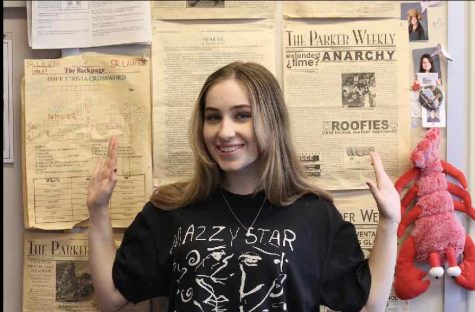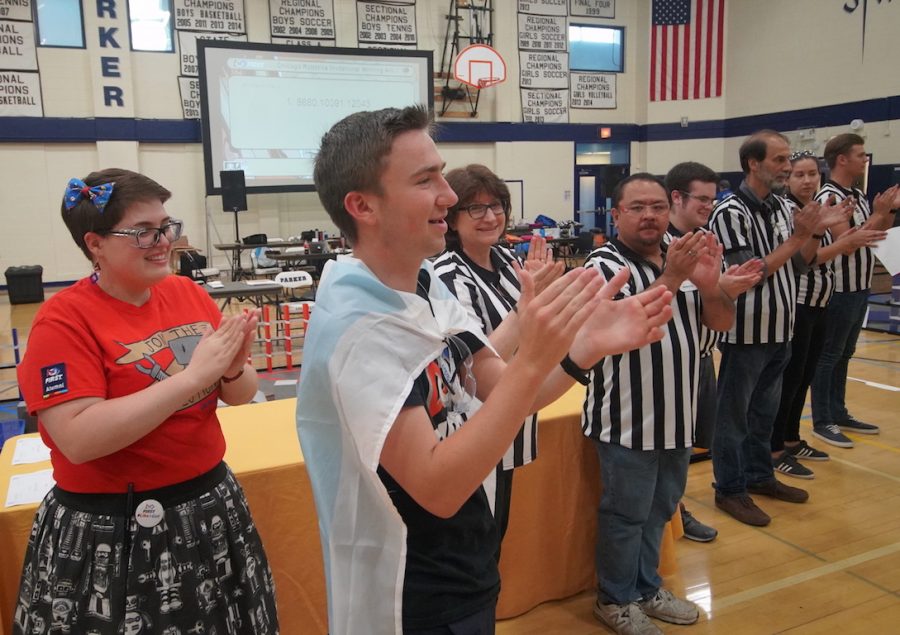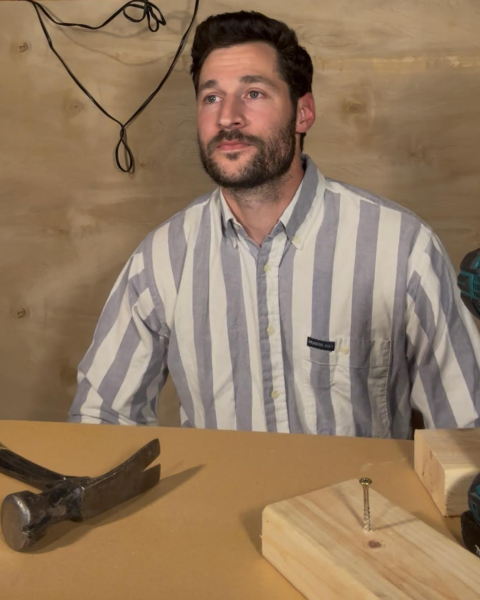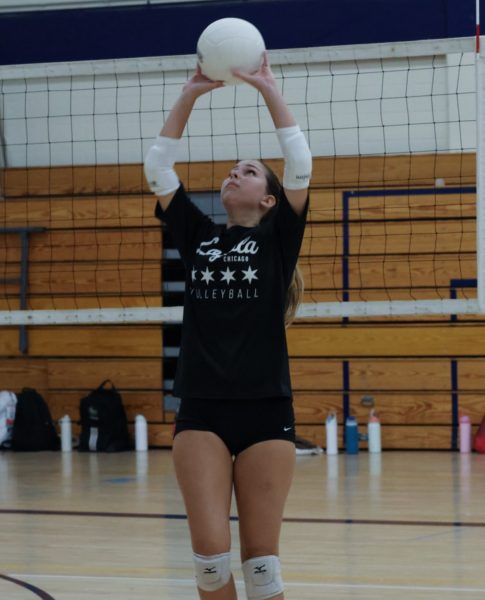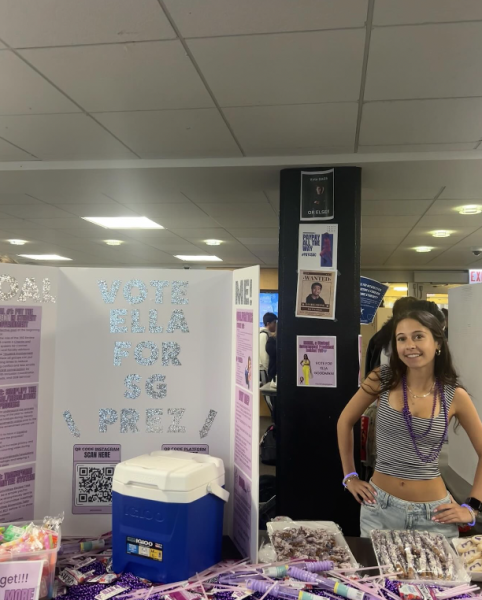Parker’s First FIRST
Parker Hosts Chicago Robotics Invitational
Photo credit: Nathan Satterfield
Nathan Satterfield, one of the heads of the upper school’s robotics team Robo Theosis, claps at the Chicago Robotics Invitational this summer.
While official preseason for Parker sports started August 6th, Parker’s robotics kids were at school on Friday, June 20th and Saturday, June 21st preparing for a postseason of sorts. The inaugural Chicago Robotics Invitational, hosted at Parker and planned by senior Nathan Satterfield, allowed 21 teams and around 25 volunteers from across the midwest to bond over robotics play. “I’ve always wanted to go to an off-season event, but the vast majority of them are pretty far away and we don’t really have the luxury of being able to go to events over the summer,” said Satterfield.
From the parent-filled bleachers, you can spot shirts that declare “There is no off season,” and a black-and-red mohawk that fits right in with the inflatable-thumbs-up baseball caps. Typically to get here, it’s crucial to rely on teachers, mentors, and kids who aren’t always excited about a three-hour trek for robotics during summer break.
Instead, Satterfield “brought the problem onto themselves and was like, ‘Hey, why don’t we host an event?’” He wanted to host a Parker event for the underserved FIRST Tech Challenge robotics division that would get people excited and involved for years to come.
According to Satterfield, an event like this one normally takes about six months to plan. He started planning at the end of April, and since school ended has spent around four hours every day trying to get ready on his timeline. “There’s no instructional book that’s like, ‘do this, do that.’ I just kinda based [planning] off my instincts.”
Satterfield has attended around ten events during his robotics career, where he’s met other volunteers and event planners who helped get the CRI running. “I asked a few other Chicago event planners, ‘Hey, how do I do this? What do I do here?’ I really just used my connections in the [robotics] community… to help me plan the event,” Satterfield said.
“There’s a lot of moving parts and it’s really impressive to see a student step up to take on almost all of those moving parts,” game announcer Kori Bowns said.
To cover the costs, teams were charged $50 for registration, which went mostly towards food. “The upfront cost is a lot and then in the future we’ll have all the cables, have everything we really need, and really the base expense is food and pizza,” Satterfield said. The competition fields were crowdsourced from neighboring teams, so the other main expense was the banners for the winning alliances.
Parker robotics teacher Aaron Lee helped Satterfield organize and communicate with Parker. The school provided the Big and Small Gym, some basic equipment, security, and maintenance teams for setup and teardown. Dr. Frank gave opening remarks to kick-off day two.
To get the word out to participants, Satterfield said he posted everywhere he could online – Facebook, Twitter, Reddit, and the FTC Dischord. He reached out to other high school teams from nearby states and to the entire 42-team Chicago League. The event included teams from 9 different states, including Wisconsin, Indiana, Missouri, Iowa, Ohio, and Minnesota, with two Romanian teams dropping out last minute.
“I’ve learned so much about the ins-and-outs of the competition and all the crappy politics, which is nice to know because I want to run events in the future,” said Satterfield.
During the school year, high school teams can compete in two different divisions. The FIRST Tech Challenge (FTC) is made of smaller teams and costs about $1,000-$5,000 per season. The FIRST Robotics Challenge (FRC), has teams with 10-30 members and can cost over $50,000 for veteran teams. FTC and FRC have different themes for their competition fields.
Event emcee Ryan Kamphuis noted that within FIRST, the broader robotics organization, the FTC program is often seen as the JV level. “I think what I really would like people to take away from this is that there are a lot of highly competitive teams that are willing to keep the season going year round,” Kamphuis said.
This season’s theme for FTC was Relic Recovery. According to competition materials, alliances can earn points by “(1) scoring Glyphs into the Crypto Boxes and completing rows, column, and ciphers, (2) transferring Relics to the Recovery Zone, (3) retrieving Jewels, (4) parking on the Balancing Stones, and (5) navigating to specific parts of the Playing Field.”
“It’s a modified competition because we wanted to add a little spice,” Satterfield said. “They’re coming to play the game they know but also just adds a little something more to make it worth their while.” Bowns said they added more cryptoboxes, relics, glyphs, and time.
Satterfield also eliminated the typical half-hour inspection of software and hardware, which normally verifies that teams are following the rules. “It’s a good group of people, good group of teams who are highly competitive and have knowledge of the competition, so the major difference is we’re prioritizing robot play and having fun on the field and kind of getting rid of all the unnecessary, off-the-field jargon and work,” Satterfield said.
All gameplay was narrated––ESPN-style––by Bowns for the benefit of event attendees and for those watching the live stream, broadcasted at twitch.tv, from home.
Finals were played best out of three by the top two alliances. The ‘Red’ Alliance, led by team 99999, Turbo Charge, with teams 9790 and 12835 competed against the ‘Blue’, led by team 8680, Kraken-Pinion, with teams 10091 and 12043. The Red Alliance won in the first two matches, and set the high score for the day. Satterfield recognized teams besides the finalists with awards like the ‘World Traveler’ (going to Tesla’s Nights with 512 miles of travel).
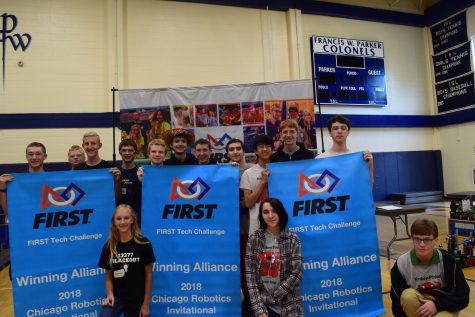
Winners of the FIRST Tech Challenge mile that the Chicago Robotics Invitational held at Parker this summer.
“This is the last time [competing teams are] going to use these robots in competition so [this is] kind of a last hurrah for these robots, [teams who] get to revisit those, and get [teams] excited about the upcoming season,” said Lee.
This year, all teams who registered were accepted. “In the foreseeable future, it looks like we might be in a position where we have to decide which teams we would like to come,” Satterfield said. The absolute maximum for an invitational is 36 teams.
Satterfield is a senior and is already making plans for what the event might look like after he graduates. “I haven’t found someone yet,” Satterfield said. “I do know that I could plan this one more time, but I want it to be around for three, four, five, plus [years], another decade.”
Meanwhile, Lee is looking forward to the next FTC season, ‘Rover Ruckus 2’. “We’re getting an earlier jump on this next season than we ever have. We’ve got [the CRI], we also have another event our first weekend back,” Lee said. “This is going to be a really experienced veteran team coming back, so I think we have a lot going for us for the upcoming season.”
